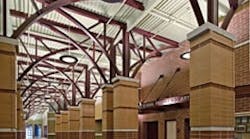School design has developed into a specialized area in the interior design field. When considering candidates for a school or university project, education institutions should move beyond a prospective designer's resume of experience and accomplishments in order to get a better handle on what to expect when working together. Five areas — “the 5 Cs” — play an important role in helping a project run smoothly and creating a successful school interior environment:
-
Communication is key when hiring an interior designer. During a project, communication should be frequent and robust. The team needs to be able to bounce ideas off each other and discuss options freely. They must be able to understand each other's point of view and connect with each other. If they are not on the same wavelength, the project will suffer.
-
Commitment. How dedicated to the project goals is the interior designer? All involved in the project must have a compelling reason for doing what they are doing and a desire to improve upon an idea or a space or a theme. Together, they must be committed to finding solutions, even during the challenging times of budget crunches and time constraints.
-
Clarity. Does the interior designer appear to be organized and a clear thinker? With each project, a host of design-related details must be coordinated, so being organized and having a good business sense is important — and that includes keeping up with things as mundane as meeting notes.
During the planning stages of a project, it's important for an interior designer to work through design details with the architect and contractor. Find out whether what the team is dreaming about can be built and is affordable. And what happens if materials are discontinued? Or if the contractor wants to substitute other materials that are less expensive (and perhaps of inferior quality)? Following up — clearly and concisely — in a timely manner to situations like these is another way a well-qualified interior designer can handle project challenges.
-
Creativity. Talk to prospective interior designers about the creative process and what it means to them. How do they approach a project creatively? Do they have passion for what they are creating? What kinds of things do they do to brainstorm solutions? How do they present these ideas? Do they personalize the solution for a school or is it a cookie-cutter solution? Seek out unique and interesting approaches to the project, so there is a meaningful story for the facility that everyone understands and can tell others about. It's exciting to be part of a team working to create a meaningful learning environment where staff and students can excel.
-
Color. In his book Color, Environment, and Human Response, author Frank H. Mahnke writes, “As one (professional) has stated: ‘In the past, it was believed that schools must be colorful, but that is over. Children bring enough life into the rooms. A discreet light gray in a concrete-tone, so to speak, is therefore, the right choice for school buildings.’” But Mahnke contends, “What is forgotten here is that the more impersonal the schoolroom, the more it will encourage liveliness as a compensation. An impersonal environment brings about a reaction. In this case, the room devoid of visual pleasure or a sense of caring channels the children's feelings toward irritability, fidgeting, etc.”
Using certain colors can help create environments that are safe, interesting and conducive to studying — while promoting mental and physical health.
There is no substitute for well- qualified people on the team. Take time to investigate who will be most capable to solve challenges and work the hardest. Find someone who is there to serve the institution and its design, not his or her own ego.
Bamborough, IIDA, is director of interior design at GMB Architecture + Engineering, Holland, Mich. She can be reached at (616)796-0200.



